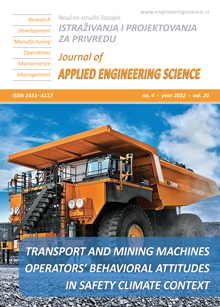BEHAVIORAL EVIDENCE OF PUBLIC AIRCRAFT WITH HISTORICAL DATA: THE CASE OF BOEING 737 MAX 8 PK-LQP
Abstract
This paper studies a significant amount of residual evidence characterized by the historical flight trajectory of PK-LQP (B737 MAX 8), which underwent an accident. Subsequently, this method is employed to generate novel safety-relevant knowledge based on existing flight data. At the beginning of this study, the method is applied by developing the hypothesis with the support of all data collected from online and offline reports, ADS-B data from flightradar24, and a statistical approach. This preliminary study employs Python as an essential program for the purpose of data collation and analysis. The results show that in the data offered by KNKT (The Indonesian National Transportation Safety Committee-Indonesia), the aircraft (PK-LQP) demonstrated unusual behaviour in comparison with the typical climbing phase that is produced by the dataset valid B737 MAX 8 (the ground truth data). The results also confirmed the hypothesis proposed in this study.
References
Mostafa, A. (2020). Safety and Risk Assessment of Civil Aircraft during Operation. In (Ed.), Safety and Risk Assessment of Civil Aircraft during Operation. IntechOpen. London. DOI: 10.5772/intechopen.93326
FAA (2016). Pilot ’ s Handbook of Aeronautical Knowledge FAA-H-8083. U.S Department of Transportation, Oklahoma.
Wendel, W. B. (2019). Technological Solutions to Human Error and How They Can Kill You: Understanding the Boeing 737-Max Products Liability Litigation. Cornell Law Sch Leg Stud Res Pap Ser, pp. 19–47, DOI: 10.2139/ssrn.3430664
Farjadian, A. B., Annaswamy, A. M., Woods, D. (2017). Bumpless Reengagement Using Shared Control between Human Pilot and Adaptive Autopilot. IFAC-PapersOnLine, vol. 50, no. 1, pp. 5343–5348. DOI: 10.1016/j.ifacol.2017.08.925
Wallius, E., Klock, A. C. T., Hamari, J. (2022). Playing it safe: A literature review and research agenda on motivational technologies in transportation safety. Reliability Engineering & System Safety, vol 223, no 108514. DOI : 10.1016/j.ress.2022.108514
Li, L., Das, S., Hansman, R. J., Palacios, R., Srivastava, A. N. (2015). Analysis of Flight Data Using Clustering Techniques for Detecting Abnormal Operations. J Aerosp Inf Syst, vol. 12, no. 9, pp. 587–598. DOI: 10.2514/1.i010329
Seyer, K., Londner, E. (2020). Case Study of the Boeing 737 MAX 8 Crashes Using a Systems Thinking Approach. Proceedings of the 2020 Annual General Donald R. Keith Memorial Capstone Conference A Regional Conference of the Society for Industrial and Systems Engineering, pp. 93–100.
KNKT (2019). Aircraft Accident Investigation Report, KNKT.18.10.35.04, PT. Lion Mentari Airlines, Boeing 737-8 (MAX), PK-LQP, Komite Nasional Keselamatan Transportasi, Jakarta, Indonesia
Demirci, S. (2022), The requirements for automation systems based on Boeing 737 MAX crashes, Aircraft Engineering and Aerospace Technology, Vol. 94 No. 2, pp. 140-153. DOI: 10.1108/AEAT-03-2021-0069
Wang G, Zhao W (2020). The Principles of Integrated Technology in Avionics Systems. Academic Press Elsevier. DOI: 10.1016/B978-0-12-816651-2.00003-4
Boeing (2017). Statistical Summary of commercial Jet airplane accidents worldwide Operations 1959-2017. From https://aviation-safety.net/airlinesafety/industry/reports/Boeing-Statistical-Summary-1959-2017.pdf. style="mso-spacerun: yes;"> Accessed on 2019-08-07.
Schäfer, M., Strohmeier, M., Lenders, V,. Martinovic, I., Wilhelm, M., (2014). Bringing up OpenSky: A large-scale ADS-B sensor network for research. IPSN-14 Proceedings of the 13th International Symposium on Information Processing in Sensor Networks. p 83–94.
Dhief, I., Dougui, N.H., Delahaye, D., Hamdi, N.(2016). Strategic planning of aircraft trajectories in North Atlantic oceanic Airspace based on flocking behaviour. 2016 IEEE Congress on Evolutionary Computation (CEC). p. 2438-2445
Tanner, A., Strohmeier, M. (2019). Anomalies in the Sky: Experiments with traffic densities and airport runway use. Proceedings of the 7th OpenSky Workshop 2019. vol. 67, pp. 51–38.
Kätsyri J, Förger K, Mäkäräinen M, Takala T (2015) A review of empirical evidence on different uncanny valley hypotheses: support for perceptual mismatch as one road to the valley of eeriness. Front. Psychol. 6:390. DOI: 10.3389/fpsyg.2015.0039
FLipton, P. (2017). Inference to the best explanation. W. H. Newton-Smith (Editor). A Companion to the Philosophy of Science, Blackwell Publisher, p 184-193.
Harris, E. E. (2014). Hypothesis and perception: The roots of scientific method. Routledge.
Schmidt B, Labib A, Hadleigh-Dunn S (2020). Learning and unlearning from disasters: an analysis of the Virginia Tech, USA shooting and the Lion Air 610 Airline crash. J Surveill Secur Saf;1 1-15. DOI: 10.20517/jsss.2019.02
Zhang, X., Zhang, J., Wu, S., Cheng, Q., Zhu, R. (2018). Aircraft monitoring by the fusion of satellite and ground ADS-B data. Acta Astronaut, vol. 143, p. 398–405. DOI: 10.1016/j.actaastro.2017.11.026
Nuryantini, A.Y., Nuryadi, B.W (2019).Learning vector of motion using FlightRadar24 and Tracker motion analysis.Physics Education. IOP Publishing. VOL 55, NO 1 P 015019. DOI:10.1088/1361-6552/ab5393.
Meyer, A (2016). ICAO Big Data Project ADS-B Data as a source for analytical solutions for traffic behaviour in airspace. From https://www.icao.int/SAM/Documents/2016-SAMIG17/SAMIG17_ADSB.pdf Accessed on 12 January 2021.
Zhang, J., Liu, W., Zhu, Y. (2011). Study of ADS-B data evaluation, Chinese J Aeronaut, vol. 24, no. 4, 461–466. DOI: 10.1016/s1000-9361(11)60053-8
Chandola, V., Banerjee, A., Kumar, V. (2009). Survey of Anomaly Detection. ACM Comput Surv, vol. 41, no. 3, pp. 1–72. DOI:10.1145/1541880.1541882
Li, L., Hansman, R.J. (2013). Anomaly Detection in airline routine operations using flight data recorder data. Thesis. MIT International Center for Air Transportation(ICAT). Massachussets Institute of Technology, Cambridge.
Nowacki, M., Olejniczak, D. (2018). Analysis of Boeing 737 MAX 8 Flight, in Terms of the Exhaust Emission for the Selected Flight. Transportation Research Procedia, vol. 35, pp. 158–165. DOI:10.1016/j.trpro.2018.12.033
Pusadan, M. Y. , Buliali, J. L., Ginardi, R. V. H (2019). Cluster phenomenon to determine anomaly detection of flight route. Procedia Computer Science, vol. 161, pp. 516–526. DOI: 10.1016/j.procs.2019.11.151

